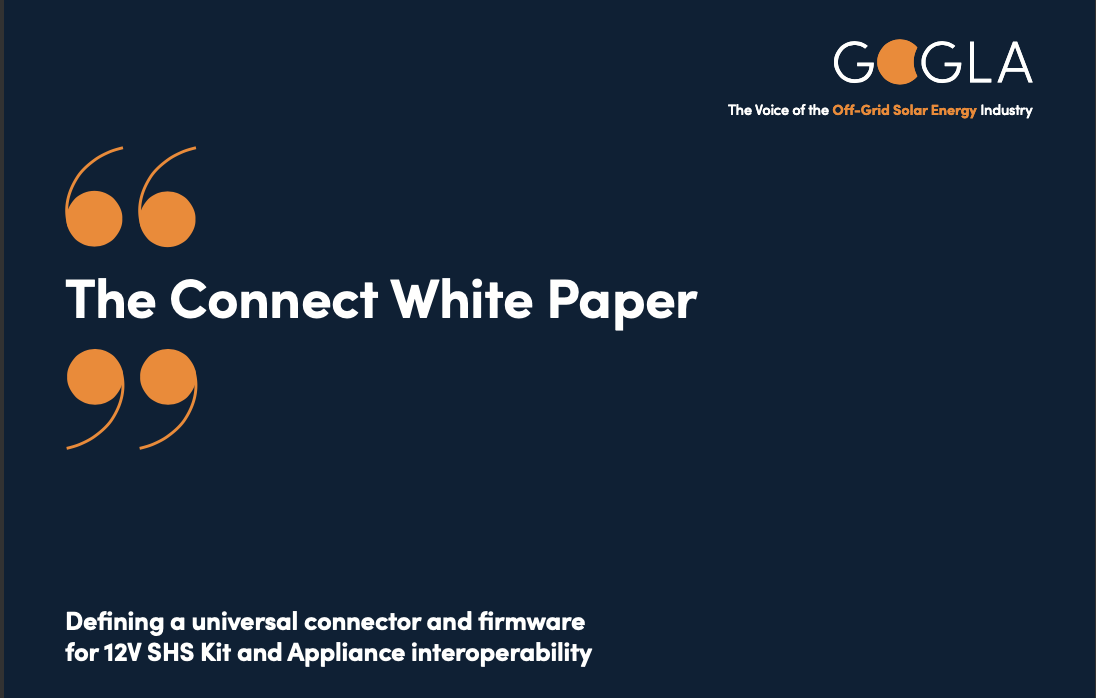This article was first published on LinkedIn on 2 July 2021.
Over the past two months I have been working with Drew Corbyn and the team at GOGLA on a White Paper, which lays out proposals to define a universal connector and PAYGo software standards for solar kits and appliances. The Connect Initiative – as it is called – aims to promote interoperability in the off-grid solar industry and in the process increase consumer freedom and enable the development of new business models.
You can download the White Paper here: https://www.gogla.org/resources/the-connect-white-paper

To coincide with the White Paper’s publication, a session was held at GOGLA’s AGM in June, during which I moderated a discussion with three stakeholders from the off-grid solar ecosystem: Tori Arch, co-founder and COO of Angaza, which developed the Nexus Channel application layer for the Connect Initiative; Patrick Walsh, co-founder and CEO of Greenlight Planet, a vertically-integrated provider of solar kits and appliances; and Godfrey Katiambo, Head of Sales and Operations at SUNami Solar, a solar PAYGo company based in Kenya
Here are my six takeaways:
1) The Connect Initiative is ultimately about consumers and increasing their freedom of choice. This means freedom to switch service providers (rather than being locked into one provider of SHS Kits and appliances) and to source appliances from a wider range of suppliers. It also aims to end the frustration that consumers can feel at having to use multiple chargers and cables, as well as their struggle to find replacements for proprietary connectors and spare parts in rural areas.
2) When it comes to the potential benefits, Godfrey said that universal standards could reduce costs for manufacturers and distributors, with the savings passed on to consumers. Tori cited estimates that adopting the Connect communications protocol could save 120 engineering days per integration – a huge potential saving in R&D costs which could be deployed elsewhere. Patrick was sceptical that universal standards would result in significant cost savings in the short term, but he warned that the negative costs of NOT adopting interoperability would be felt in the long-term through ‘death by a thousand modifications’, as engineers to try to make increasingly non-compatible technology work together.
3) In our discussions, a number of analogies were drawn for how the Connect Initiative could work in practice. The planned ecosystem was compared to the Apple and Microsoft model, with closed proprietary brands operating alongside ‘Connect Affiliates’ and a fully ‘Open Ecosystem’. The model for cooperation was compared to Project Connected Home, which involves close collaboration between bitter commercial rivals – Amazon, Apple and Google – to create common connectivity standards for smart home appliances in industrialised markets. But perhaps the most striking analogy was the description of how the hardware and firmware layers communicate: by adopting the Connect standards, it is like agreeing to speak in English (language) and on the telephone (means of communication).
4) A poll of delegates indicated that most people expect that between 40% and 60% of the market will adopt the Connect Standards and join the Connect Affiliate network. This reflects the dominance of vertically-integrated providers for whom interoperability is often viewed more as a threat than as an opportunity. However, as Patrick said, it is not necessary to have 100% adoption of the Connect Standards or for all SHS Kits and appliances to be fully interoperable. Some manufacturers and distributors may wish to fully adopt the standards, while others may choose to open up only part of their system to interoperability. Godfrey noted that small companies like SUNami Solar are ready to jump on bandwagon, but they are waiting for the big companies to take the lead first.
5) Consumers already try to connect devices that shouldn’t be connected, often splicing cables and rigging together wires. This is unreliable and dangerous, and contributes to the relatively short lifespan of electronic devices in Africa. Standards would help reduce these risks. Patrick noted that companies tend to coalesce around standards naturally, and even adopt them before they are official or legally required, which is a good reason to start work on developing them now.
6) In the long run, interoperability can exert a pull which is impossible to resist. Even Apple – which has experimented with proprietary cables (e.g. magnetic and Lightening) – has been drawn into the USB-C world. Over time, the Connect Technical Guidelines could exert a similar pull and drive companies to coalesce around a set of standards.
If you’d like to listen to the best parts of our discussion, it’s all on the podcast I published today here: https://bit.ly/3Ao1ACk